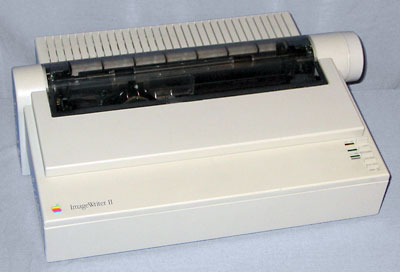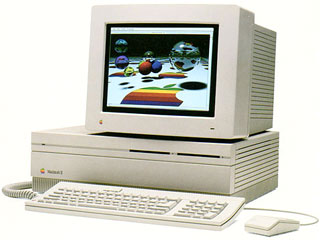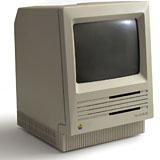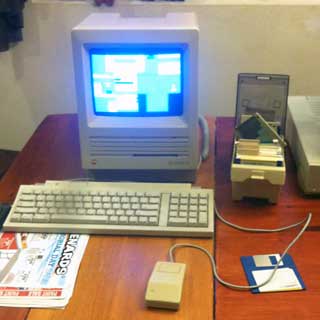I had been on the lookout for another Mac to add to my collection. My wife had led me to believe that if I was so inclined to pick up another, that it should be free or very close to it. I posted some ads on the local buy/sell Facebook groups and even on the Low End Mac Swap List. I had a few offers from the LEM Swap List, but they weren’t what I was looking for. I wanted a fast 68K powered Mac.
I really like all of the computers from the “Snow White”’ design language. They remind me of my family’s first computer, an Apple IIc.
The Mac IIfx is by far my favorite from that generation of Macs. Anything that was coined with “wicked fast” had to be great, and I’ve never used a 68040 before, which also leads me to my next favorite 68k powered computer – the Quadra 900/950.
The case of the Quadra 900/950 is just ginormous. It was also the first Mac to have 6 expansion slots since the IIfx. I was really looking to find something to experiment with, and lots of expansion slots in a big ‘ole case would be perfect.
After a few weeks without a hit, I resorted to freecycle. For those that have never heard of freecycle, it is an email group that helps keep things out of landfills by donating to people that would use them. Boy, did my quarry fit this. I would be more than happy to drive somewhere to take a 20+ year old Mac that was sitting around collecting dust off someone’s hands. I was contacted by a local saying he had an old Mac and a printer that I could have. Score! We arranged a time and date for pickup, and I left to get the combo a few days later.
 When I got there I was met at the door with a loaded compact Mac carry case with a keyboard sticking out of the top. It obviously wasn’t the enormous tower or the 68040 powered speed demon I was searching for, but a free Mac is a free Mac. He returned to the door with an ImageWriter II and a desktop storage case with a bunch of 3.5” floppy disks. I thanked him kindly and took my new toys to my van.
When I got there I was met at the door with a loaded compact Mac carry case with a keyboard sticking out of the top. It obviously wasn’t the enormous tower or the 68040 powered speed demon I was searching for, but a free Mac is a free Mac. He returned to the door with an ImageWriter II and a desktop storage case with a bunch of 3.5” floppy disks. I thanked him kindly and took my new toys to my van.
Upon further inspection of my new finds, I found my new Mac to be an SE with 1 MB of RAM and a 20 MB hard drive. It and it’s accompanying keyboard and mouse were slightly yellowed, but I’ve come to expect that.
The Imagewriter came with the printer cable, a ribbon, and a piece of paper jammed into it. I unjammed the printer and powered it on. No error lights were lit up, they were all green.
The SE started up quickly to a relatively clean System 4 desktop. The mouse didn’t like to be tethered through the keyboard, but when I plugged each of them into their own ADB port, everything worked fine. Waiting in the box of disks were Aldus Pagemaker, HyperCard, Microsoft Word, and Microsoft File.
I smoothed the old single piece of paper out as best I could, spun the printer ribbon around a few times and opened up Microsoft Word on the SE. I wrote the word test and tried my test print. After a few seconds, the printer ground to life and spat out the crinkled page with the faded word test in the upper left corner. Success!
 I used my MacBook and Power Mac 6100/66 to copy a set of System 6.0.8 disks and got to updating to the venerable System 6. I had to first download the disk images from the Apple site and rip them onto a CD, and then make bootable floppy images on the 6100. After it was complete, my son and I played a few games I had for the old girl, namely Dark Castle and Shuttlepuck Cafe.
I used my MacBook and Power Mac 6100/66 to copy a set of System 6.0.8 disks and got to updating to the venerable System 6. I had to first download the disk images from the Apple site and rip them onto a CD, and then make bootable floppy images on the 6100. After it was complete, my son and I played a few games I had for the old girl, namely Dark Castle and Shuttlepuck Cafe.
When my wife arrived home from her shopping trip, I attempted to have a ‘”power on” race with her new Asus laptop loaded with Windows 8.1. I shut down my SE, flipped the switch off and then back on. I was greeted to nearly complete silence as the over 25-year-old 20 MB SCSI drive spun down and failed to spin back up.
I popped in Disk 2 of System 6.0.8, as this has a bootable System Folder and the hard drive utility. It couldn’t find anything on the SCSI bus. After multiple reboots that all resulted in the image of a floppy disk with a question mark on it, I flipped its power button to the off position and left it alone. Of course, my wife blames herself and her “negative tech juju”, but the truth is she didn’t kill my hard drive with her negativity. It had more than likely developed a case of stiction. This is where the lubrication the helps the head move across the hard drive platters becomes thicker, and it can actually cause the head to stick to the platter and render it inoperable.
My little SE works just fine from the floppy drive. I don’t have an external floppy, and it’s extremely annoying flipping those in and out all the time to try to use it. Since I don’t have one of the longer T15 screw drivers to open up the case, this is where the story ends for now.
On the next installment of the SE Experience, I will document the hard drive replacement, solder joint inspection, and memory upgrade.
Keywords: #macse #macintoshse #macpackrat
Short link: http://goo.gl/KZmuNg
searchword: macseexperience






Replacing the hard drive and the memory isn’t too difficult but there are a few precautions to make that experience less nerve wracking.
Sounds like the case has been cracked to replace the PRAM battery in the past. That will make the process a little easier. Use a Torx T15 to loosen the screws visible in the bottom and in the built in handle. The Torx T15 is a fairly common tool these days and should have at least an 8 inch shank to reach the Torx screws in the handle. I bought mine at Sears a few years ago. Check your local listings.
I usually use the sofa and place the SE SCREEN DOWN, loosen all the screws and than slap the sides not too hard to loosen them. The back cover should be loose enough to lift right off.
Very important, gently remove the connection to the CRT NEAREST to the back. There isn’t a lot of space inside and the possibility of bumping that connection and breaking the vacuum of the CRT will be greatly reduced. Voice of experience here.
There will be an RF shield on the bottom that you can remove. Remove the PDS adapter as well. I usually put all the parts I remove in the back case so I won’t loose any small screws in the shag carpet. You’ll need to remove the logic board because there are four screws securing the drive cage and floppy drive to the main framework of the Mac.
Space is limited to work in. To get the logic board out remove the power supply/monitor connection , floppy drive connection and, the hardest, for me is the SCSI connection to the logic board. Now gently pull the logic board from the tabs on the back just about an inch and the logic board should swing out enough to disconnect the speaker connection. It’s a lot of work and a bit nerve wrecking for a first timer. Just relax. You can do this.
There are two kinds of batteries used in the SE. The early batteries have leads that are soldered into the logic board. Later models use a battery cage. Usually all 800K drives models have the soldered battery unless they have been upgraded in which case the front, under the Macintosh SE will be HDFD. These batteries are fairly easy to find on the net and prices do vary. Google knows everything.
So you think you can lift out the drive cage now? Not until the two screws just under the CRT are removed. A long shank on a cross head magnetized screwdriver would be helpful to remove these little buggers. Lift up very slightly to release the tabs on the bottom of the complete drive cage and it should lift right out.
Those original SCSI 20 MB drives are 1/2 height. Most 1/3 height SCSI drive will fit and you can benefit by have loads of space to over-install lots of stuff. There are four screws that attach the hard drive to its case. Sometime those holes don’t line up with “newer” SCSI replacement drive. I find that just two will hold the drive securely enough. Don’t sweat the small stuff. There are two screws under the HD cage that attach to the floppy drive and you can remove them to just take out the drive if you wish. Don’t drop those little buggers into the case because sometimes their hard to recover.
Getting the SCSI connecter off the drive can be a bit of a hassle. Have patience and if you bend a pin, most times you can use a needle nose to straighten one or two. Be careful here. They can break off. and render the drive useless.
That’s about it. Use patience and you’ll do fine with this.
I have an SE/30. I could not get the part from Sears but I did get it from MCK Hardware. It is an 8″ T-15 socket that fits into my socket screwdriver, but note that at 8″ it was just barely long enough. It was a $5 part. Simple and works like a charm.
Upgrading the RAM you will see a huge speed increase under System 6. I went t from 1 MB to 5 MB and boot time and operating speed massively increased. Even if you increase the hard drive space, you will not see the speed increase you might want with out the RAM upgrade.
Thanks for the replies, I got the memory upped to 4MB and the hard drive replaced with a 230MB model. The next installment should be released shortly.